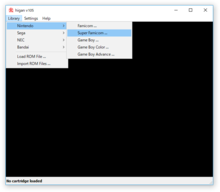higan (emulator)
 | |
 higan v105 running on Windows 10 | |
| Developer(s) | Near et al. |
|---|---|
| Initial release | October 14, 2004 |
| Stable release | 115
/ August 15, 2020[1] |
| Repository | |
| Written in | C++14, C99 |
| Operating system | Windows, Linux, macOS, FreeBSD |
| Platform | Independent: IA-32, x86-64, ARM32/64, MIPS, etc. |
| Type | Video game console emulator |
| License | GNU GPLv3 |
| Website | |
higan is a free emulator for multiple video game consoles, including the Super Nintendo Entertainment System. Originally called bsnes[2] (which was later reused for a new emulator by the same developer), the emulator is notable for attempting to emulate the original hardware as accurately as possible through low-level, cycle-accurate emulation and for the associated historical preservation efforts of the SNES platform.[3][4]
higan products family
higan has been forked and renamed over the years, and consists of three sub-projects.[5]
The current sub-projects are:
- bsnes: A Super Nintendo Entertainment System emulator with Super Game Boy support.
- higan: A multi-system emulator that focuses on accuracy. Supported systems include the Nintendo Entertainment System, Super Nintendo Entertainment System, Game Boy (Color), Game Boy Advance, SG-1000 and SC-3000, Sega Master System, Game Gear, Sega Genesis, Sega CD, TurboGrafx-16 and SuperGrafx, MSX and MSX2, ColecoVision, WonderSwan (Color), and Neo Geo Pocket (Color).
- ares: A multi-system emulator that is a fork of higan, focusing on performance and adding experimental PlayStation and Nintendo 64 support in addition to the systems supported in higan.
Overview
Development of the emulator began with the name bsnes on October 14, 2004. The first version was released in May 2005 for Microsoft Windows. The early versions would require high-power hardware to run games in a consistent manner and therefore garnered controversy.[6] Since then, it has been ported to Linux, macOS, and FreeBSD. Initially developed under a custom license, later releases were licensed under various versions of the GNU General Public License. On August 9, 2012, the project was renamed to higan, to better reflect its new nature as a multi-system emulator.
The higan project has contributed significantly to the field of SNES emulation, with a number of original achievements in its emulation, and in reverse engineering developments such as the organization of funds, hardware, and expertise for decapping the SNES's enhancement chips.[4]
higan is able to run every commercial SNES title ever released.[7] It is the first emulator to have featured SPC7110 emulation, cycle-accurate SPC 700 emulation, cycle-accurate Super FX emulation, Super Game Boy emulation,[8] and a dot-based instead of scanline-based renderer for the Game Boy Advance. It is the first multi-emulator of this breadth to achieve cycle-based emulation for every single component of every system.
Forked versions of bsnes have provided emulation support for Nintendo DS, XBAND, Super Famicom Box, Satellaview BS-X software, and tool-assisted speedruns.[9]
Author
The original bsnes developer by the pseudonym of Near (initially known as byuu) started out in the emulation scene as an amateur programmer, translating Japanese video-game ROM images at the age of 14, and one year later developed a tool for displaying resized text font in games. After that, a patching assembler by the name of xas would follow, which streamlined the ROM-translation process. The development of bsnes was triggered by bugs in translations that would only appear on the original hardware but not on 2004-era Super-Nintendo emulators; as such, the aim of bsnes was for accurate emulation.[6]
In 2019, Near retreated from the emulation scene, after "a series of escalating privacy intrusions and targeted Internet harassment" affected his mental health.[6]
In February of 2021, a new translation for the Super-Nintendo game Bahamut Lagoon got released, a passion project that Near had attempted multiple times since 1998.[6]
Reception
In 2008, British Internet magazine Webuser recommended bsnes for "some fun old-school gaming".[10] In 2009, Japanese game magazine GameLabo recommended it for "those seeking a realistic playing experience".[11]
In 2017, components of higan's source code were used to emulate the vintage text-to-speech computer used by physicist Stephen Hawking, after the original hardware began showing signs of wear. Hawking would continue using this emulator to converse with others until his death in 2018.[12]
See also
References
- ^ Higan release on GitHub
- ^ "About – bsnes". Retrieved February 3, 2021.
- ^ Near (August 9, 2011). "Accuracy takes power: one man's 3GHz quest to build a perfect SNES emulator". Ars Technica. Retrieved March 11, 2015.
- ^ a b Fenlon, Wesley. "16-bit Time Capsule: SNES Emulator Makes a Case for Software Preservation". Archived from the original on February 4, 2013. Retrieved June 27, 2021.
- ^ About ares
- ^ a b c d Patrick Klepek (March 8, 2021). "A 23-Year Perfectionist Journey to Localize the Obscure 'Bahamut Lagoon'". Vice. Retrieved June 27, 2021.
- ^ Bannister, Richard (February 2006). "Emulation Nation: Interview – Richard Bannister". Retro Gamer (Interview). No. 21. Interviewed by Craig Grannell. p. 97.
- ^ "The State of Emulation, Part III". near.sh. Retrieved February 3, 2021.
- ^ "tasvideos.org Preferred Emulators". tasvideos.org. Retrieved May 13, 2012.
Isnes
- ^ "Downloaded". Webuser (191): 39. 2008.
- ^ "SFC". GameLabo (September): ?. 2009.
- ^ Jason Fagone (March 18, 2018). "The quest to save Stephen Hawking's voice". San Francisco Chronicle. Retrieved March 19, 2018.
External links
- Official website
- Linux packages for various distributions
